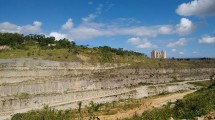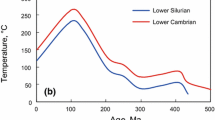Abstract
Generally, there are some anhydrites in carbonate reservoir, as H2S is also familiar in carbonate oil and gas reservoirs. Nowadays, natural gas with high H2S concentration is usually considered as TSR origin, so there is close relationship between H2S and anhydrite. On the contrary, some carbonate rocks with anhydrite do not contain H2S. Recently, researches show that H2S is only a necessary condition of H2S formation. The reservoir porosity, sulfate ion content within formation water, reservoir temperature, oil/gas and water interface, hydrocarbon and some elements of reservoir rock have great controlling effects on the TSR occurrence. TSR deoxidizes hydrocarbon into the acidic gas such as H2S and CO2, and the H2S formation is controlled by TSR occurrence, so the relationship among reaction room, the contact chance of sulfate ion and hydrocarbon, the reservoir temperature has great influence on the TSR reaction. H2S has relatively active chemical quality, so it is still controlled by the content of heavy metal ion. Good conditions of TSR reaction and H2S preservation are the prerequisite of H2S distribution prediction. This paper builds a predictive model based on the characteristic of natural gas reservoir with high H2S-bearing. In the porosity reservoir with anhydrite, the formation water is rich in sulfate and poor in heavy metal ion. Oil and gas fill and accumulate in the gas reservoir with good preservation conditions, and they suffered high temperature later, which indicates the profitable area of natural gas with high H2S-bearing.
Similar content being viewed by others
References
Dai J X. Distribution, classification and origin of nature gas with hydrogen sulphide in China. Acta Sed Sin (in Chinese), 1985, 3(4): 109–120
Orr W L. Changes in sulfur content and isotopic ratios of sulfur during petroleum maturation-Study of the Big Horn Basin Paleozoic oils. AAPG Bull, 1974, 50: 2295–2318
Krouse H R, Viau C A, Eliuk L S, et al. Chemical and isotopic evidence of thermochemical sulphate reduction by light hydrocarbon gases in deep carbonate reservoirs. Nature, 1988, 333(2): 415–419
Worden R H, Smalley P C, Oxtoby N H. Gas souring by thermochemical sulfate reduction at 140°C. AAPG Bull, 1995, 79(6): 854–863
Dai J X, Hu J Y, Jia C Z, et al. Suggestions for scientifically and safely exploring and developing high H2S gas fields. Petrol Explor Devel (in Chinese), 2004, 31(2): 1–5
Machel H G, Krouse H R, Sassen R. Products and distinguishing criteria of bacterial and thermo-chemical sulfate reduction. Appl Geochem, 1995, 10(4): 373–389
Zhu G Y, Zhang S C, Liang Y B, et al. Isotopic evidence of TSR origin for natural gas bearing high H2S contents within the Feixianguan Formation of the northeastern Sichuan Basin, southwestern China. Sci China Ser D-Earth Sci, 2005, 48(11): 1960–1971
Zhang S C, Zhu G Y, Liang Y B, et al. Geochemical characteristics of the Zhaolanzhuang sour gas accumulation and thermochemical sulfate reduction in the Jixian Sag of Bohai Bay Basin. Org Geochem, 2005, 36(11): 1717–1730
Zhu G Y, Zhang S C, Liang Y B, et al. Discussion on origins of the high-H2S-bearing natural gas in China. Acta Geol Sin, 2005, 79(5): 697–708
Cai C F, Worden R H, Bottrell S H, et al. Thermochemical sulphate reduction and the generation of hydrogen sulphide and thiols (mercaptans) in Triassic carbonate reservoirs from the Sichuan Basin, China. Chem Geol, 2003, 202(1): 39–57
Shen P, Xu Y C, Wang J J, et al. Stable sulfur isotopic composition of hydrogen sulfide from nature gas and its sedimentary geochemical facies. Acta Sed Sci (in Chinese), 1997, 15(2): 216–219
Zhu G Y, Zhang S C, Liang Y B, et al. The origin and evidence of H2S in Weiyuan Field, Sichuan Basin. Chin Sci Bull, 2006, 51(23): 2780–2788
Wang Y G, Dou L R, Wen Y C, et al. Origin of H2S in Triassic Feixianguan Formation gas pools, Northeastern Sichuan Basin, China. Geochimica (in Chinese), 2002, 31(6): 517–524
Li J C, Ma Y S, Zhang D J, et al. Some important scientific problems on petroleum exploration in marine formations of China. Petrol Explor Devel (in Chinese), 1998, 25(5): 1–2
Zhang S C, Liang D G, Zhang B M, et al. The Generation of Marine Origin Petroleum (in Chinese). Beijing: Petroleum Industry Press, 2004.
Dai J X, Qin S F, Tao S Z, et al. Developing trends of nature gas industry and the significant progress an nature gas geological theories in China. Natur Gas Geosci (in Chinese), 2005, 16(2): 127–142
Zhang S C, Zhu G Y. Gas accumulation characteristics and exploration potential of marine sediments in Sichuan Basin. Acta Petrolei Sin (in Chinese), 2006, 27(5): 1–8
Ma Y S, Cai X Y, Li G X. Basic characteristics and concentration of the Puguang Gas Field in the Sichuan Basin. Acta Geol Sin (in Chinese), 2005, 79(6): 858–865
Zhang S C, Zhu G Y, Liang Y B. Probe into formation mechanism of H2S and high-quality reservoirs of Puguang large gas field in Sichuan Basin. Geol Rev (in Chinese), 2006, 52(2): 46–50
Ma Y S. Generation mechanism of Puguang gas field in Sichuan Basin. Acta Petrolei Sin (in Chinese), 2007, 28(2): 9–14
Zhu G Y, Zhang S C, Liang Y B, et al. Distribution of high H2S-bearing natural gas and evidence of TSR origin in the Sichuan Basin. Acta Geol Sin (in Chinese), 2006, 80(8): 1208–1218
Chen A D. Origin and migration of nature gas in Ordovician reservoir in Shan Gan Ning Basin central gas field. Acta Petrolei Sin (in Chinese), 1994, 15(2): 1–10
Yang H, Fu J H, Wei X S. Characteristics of nature gas reservoir formation in E’erduosi Basin. Natur Gas Ind (in Chinese), 2005, 25(4): 5–8
Hou L, Hu J, Tang J. Distribution and genesis of hydrogen sulfide in giant carbonate gas fields of China. Acta Petrolei Sin (in Chinese), 2005, 26(3): 26–32
Han J F, Mei L F, Yang H J, et al. The study of hydrocarbon origin, transport and accumulation in tazhong area, Tarim Basin. Natur Gas Geosci (in Chinese), 2007, 18(3): 41–51
Qin S F, Jia C Z, Li M. The difference in geochemical characteristics of natural gases between eastern and western parts in Hetianhe gas field of Tarim Basin and its origin. Petrol Explor Devel (in Chinese), 2002, 29(5): 16–18
Zhao M J. Special source of the natural gases of the Hotan River gas field and the origin of its non-hydrocarbon gases. Geol Rev (in Chinese), 2002, 48(5): 480–486
Fu L X, Chen S Y, Wang D L, et al. Natural gas pool in Ordovician reservoir in Wumaying buried-hill and its formation history. Petrol Explor Devel (in Chinese), 2002, 29(5): 25–27
Zhu G Y, Zhang S C, Liang Y B, et al. Stable sulfur isotopic composition of hydrogen sulfide and its genesis in Sichuan Basin. Geochimica (in Chinese), 2006, 35(3): 412–422
Zhu G Y, Zhang S C, Liang Y B. Dissolution and alteration of the deep carbonate reservoirs by TSR: An important type of deep-buried high-quality carbonate reservoirs in Sichuan Basin. Acta Petrol Sin (in Chinese), 2006, 22(8): 2182–2194
Li G S, et al. Producing test summery of Lei3 gas pool in Zhongba gas field. Scientific Report on Mining Area in Northwest Sichuan From Petroleum Administration of Sichuan Province, 1984
Mache H G. Bacterial and thermochemical sulfate reduction in diagenetic settings-Old and new insights. Sedim Geol, 2001, 140(1–2): 143–175
Zhu G Y, Zhang S C, Liang Y B. Relationship between palaeoenvironment and the distribution of H2S in Feixianguan Formation, NE Sichuan Province. Petrol Explor Devel (in Chinese), 2005, 32(4): 34–39
Zhang S C, Zhu G Y, Dai J X, et al. TSR and sour gas accumulation: A case study in the Sichuan Basin, SW China. Geochemica et Cosmochimica Acta (in Chinese), 2005, 69(10): 562–562 (Supp)
Liang H B, Zhu G Y, Zhang S C, et al. The evolution of faulted-basin and development of hydrocarbon source rocks in Eocene of the Jixian sag, the Jizhong depression. Petrol Geol Exper (in Chinese), 2005, 27(6): 583–587
Zhu G Y, Zhang S C, Liang Y B, Ma Y S, Zhou G Y, Dai J X. Characteristics of gas reservoirs with high content of H2S in the northeastern Sichuan Basin and the consumption of hydrocarbons due to TSR. Acta Sed Sin (in Chinese), 2006, 24(1): 79–85
Huang S Q, Luo Q H, Zhang H M, et al. Collected attached maps of the evaluation study on petroleum resources. Branch of Southwest Oil & Gas Fields, Research Institute of Exploration & Development, petroChina. 2002
Ye J R, Zhao P D, Lu M D. A study on the geothermal history and oil & gas generation dynamics of lower Paleozoic in Ordos Basin. Natur Gas Ind (in Chinese), 1997, 17(5): 3–7
Li J F, et al. Origin of H2S in nature gas from Ordovician reservoirs in Changqing gas field. New Developing of Geochemistry — Collected Papers of the Eighth Academic Conference of Nationwide Geochemistry (in Chinese). Beijing: Petroleum Industry Press, 2002. 188–192
Zheng C B. Formation and evolution of caves in main production formation in the central part of Shan-Gan-Ning gas field. J Geol Miner in North China (in Chinese), 1996, 11(1): 73–75
Zheng F Y, Huang S B, Li Z H, et al. Origin and petroleum geologic significance of hydrogen sulfide in the reservoir of deep buried-hills, Bohai Bay Basin. Petrol Explor Devel (in Chinese), 2004, 31(4): 19–21
Zhu G Y, Zhang S C, Liang Y B, et al. Alteration of thermochemical sulfate reduction to hydrocarbons. Acta Petrolei Sin (in Chinese), 2005, 26(5): 48–52
Author information
Authors and Affiliations
Corresponding author
About this article
Cite this article
Zhu, G., Zhang, S. & Liang, Y. The controlling factors and distribution prediction of H2S formation in marine carbonate gas reservoir, China. Chin. Sci. Bull. 52 (Suppl 1), 150–163 (2007). https://doi.org/10.1007/s11434-007-6022-8
Received:
Accepted:
Issue Date:
DOI: https://doi.org/10.1007/s11434-007-6022-8




